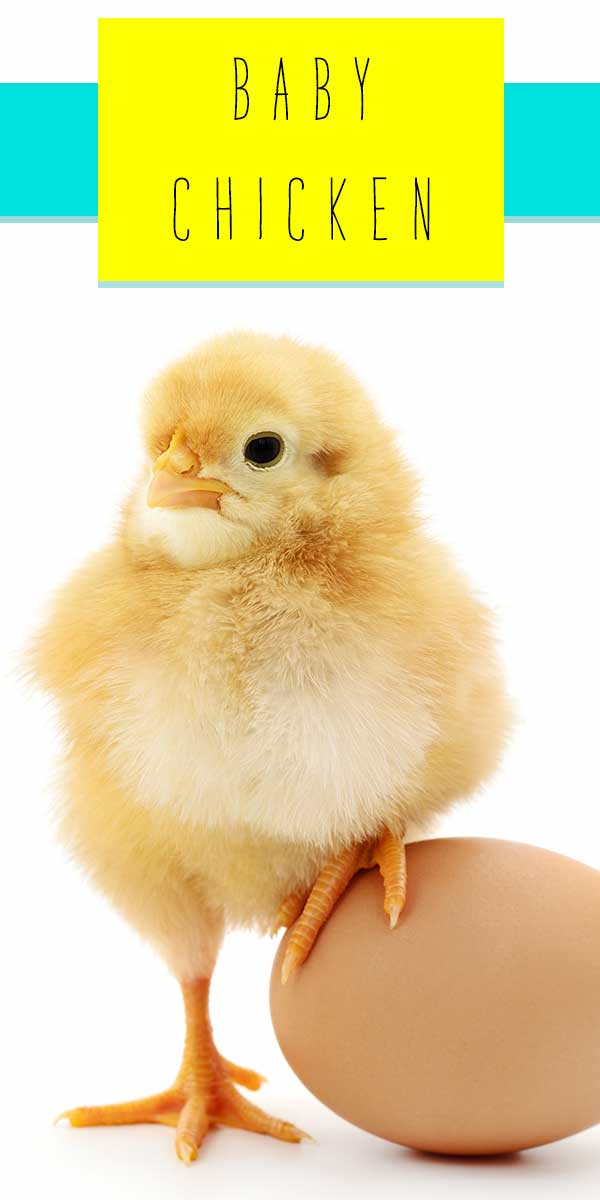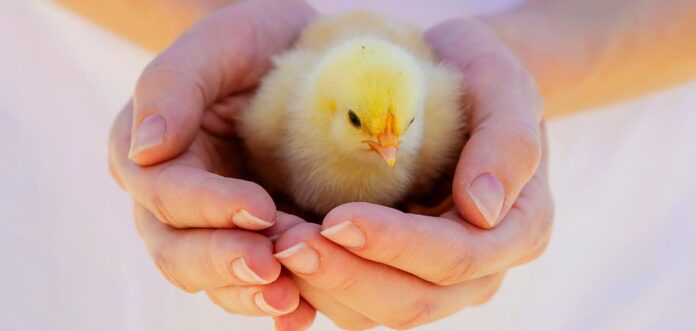A baby chicken can be taken home just one day after being born.
Baby chicks don’t need an extended period with their mom to ensure they survive and thrive.
So people looking for baby chicks for sale need to know how to raise them all the way from infancy to adulthood.
Keep reading for more information on how to care for a baby chicken.
A baby chicken is born!
Chicken eggs hatch after 21 days of incubation.
This is usually also 21 days after being laid. But the onset of incubation can be delayed by up to 10 days without losing the baby chick.
So if you’re waiting for a clutch of eggs to hatch, ask the breeder or hatchery exactly when they expect the chickens to be born.
Happy families
A hen sitting on a clutch of eggs can hatch up to 16 chicks at a time. But, broods of 10 or 12 are more common.
However, broodiness has been bred out of most modern chicken breeds kept for eggs or meat. Which means hens no longer have the instinct to sit on a nest of eggs and tend to them.
So breeders and hatcheries collect fertilized eggs and incubate them in mechanical incubators until they hatch.
Which means buyers looking for backyard chicks to rear have almost complete freedom to decide how many they would like.
Newborn chickens
A freshly hatched chick is wet and sticky from being inside their egg.
It’s important that they’re left undisturbed in the nest or incubator for a day. This allows their baby plumage to dry out.
They also continue to extract the last of the goodness from their yolk sack in this period.
But on the next day after hatching, a baby chicken is already old enough to travel to a new home. As long as that home has everything in place to rear them to adulthood.
Let’s take a quick look at what that includes next.
Caring for baby chicks
Some backyard chicken parents prefer to purchase their birds as mature layers, or ‘pullets’ – hens on the brink of starting to lay eggs.
But many people want to enjoy the experience of raising birds from as young an age as possible. Including the super cute fluffy chick stage.

This is reasonably straightforward. But baby chickens do need some special provisions which adult birds do not:
1. A high-sided brooder
Until they’re old enough to live in an outdoor coop, baby chickens are kept in a pen called a brooder.
You can buy purpose-made brooders, or you can make one yourself from materials you have available at home – even cardboard boxes.
Your brooder should be:
- big enough for each chick to have about 15 square inches of space each
- round, or have curved corners – when chicks huddle in square corners, those trapped deepest in the huddle are at risk of suffocating
- free from draughts
- lined with safe, chick appropriate bedding
- and high enough at the sides that your chicks can’t escape. 24 inches is a good rule of thumb, but a chicken wire lid is still a wise addition.
3. A heat lamp
Adult chickens are robustly suited to most climates. But, baby chickens with their downy baby feathers and high surface area to volume ratio are prone to losing body heat very quickly indeed.
So they’ll need a heat lamp over their brooder, which they can huddle under to stay warm.
The temperature under the heat lamp is controlled by raising and lowering it. So, you’ll also need something above the brooder to suspend the lamp from, and a thermometer to check the results at ground level.
The right ambient temperature for baby chicks who have just hatched is 95 degrees fahrenheit.
4. Food and water dispensers
Purpose made food and water troughs for baby chickens are inexpensive to purchase, and prevent your chicks soiling their food and drink.
Water troughs for chicks are also carefully designed to avoid chicks drowning.
If you opt for an open dish instead, it’s important to use a shallow dish with only a little water in the bottom, and refresh it regularly.
You can also add a few pebbles to the bottom of the dish. So the chicks can stand out of harm’s way, whilst sipping water from the gaps between them.
Make sure you have enough feeders to give each chick 4 inches of space at meal times.
Chicks who feel crowded will start to compete for space at the feeder by delivering vicious pecks to their companions.
5. A suitable diet – what do baby chicks eat?
Chicks need a carefully maintained balance of protein, calcium, vitamins and minerals to sustain healthy growth.
To make sure they get it, most people feed their chicks a commercial diet of ready made chick food. This is also known as “chick mash”, or “chick crumb”.
Most commercial diets already contain as much grit as chicks need for healthy digestion, but check the label. And if your chicks will be able to forage for extra snacks, make sure they have extra grit available too.
Next let’s look at how your baby chicks will grow, week by week.
One week old baby chicken
In their first week, baby chicks are at their absolute cutest.
Between 48 and 72 hours after hatching, they’ll finish extracting all the hydration and nutrition they can from their yolk. So it will be time to look for food and drink!
Chicks are naturally curious, and instinctively explore their environment by pecking at it.
So sprinkling a little chick feed near their feet from just above their heads is all it takes to pique their interest. They will peck the ground to discover what’s landed, and lo and behold, they will find their first meal!
Over the next couple of days, you can start sprinkling the food next to their feeder, and then putting it right inside the feeder.
During their first week, position your chicks’ heat lamp so the temperature at ground level is 95 degrees fahrenheit.
Two week old chicken
You might get a surprise this week if any of your chicks turn out to be early fliers.
A strong and determined chick can flap themselves over the edge of a brooder
This week, you can raise the heat lamp so the temperature below it is 90 degrees fahrenheit.
But, if you notice the chicks huddling tightly underneath it, reluctant to explore the rest of their environment, and emitting distress cries, then they’re probably too cold.
So lower the heat lamp to somewhere between the two positions, and rise it more gradually.
Three week old baby chicken
The correct temperature for a baby chicken between three and four weeks old is 85 degrees fahrenheit.
Hopefully you’ll be having lots of fun this week, watching your chicks’ personalities develop, and enjoying their avian antics.
Like all baby animals, chicks love to explore their environment. They do this by pecking, digging and scratching.
If you have fruit trees in your yard, try pruning a branch to put in their brooder.
They will enjoy pecking it, and practising flapping up into it to roost.
Four week old chicken
Your chicks will have been sprouting adult feathers for a while now, starting at the back of their necks.
And by four weeks old, their appearance will be notably more grown up.
If you’re watching them closely, you might also notice new patterns in their behavior.
Pecking Order
Groups of chickens naturally adopt a ‘pecking order’. This is a social hierarchy where more dominant individuals assert first dibs over resources like food, water and space.
As the name suggests, chicks establish this hierarchy by pecking at each other.
Usually if space, feeding stations, and waterers are in plentiful supply, then a flock will live quite peacefully once the pecking order is established.
But, keep an eye out for low ranking birds being persistently bullied away from resources.
The right ambient temperature for a 4 week old baby chicken is 80 degrees fahrenheit.
Five week old baby chicken
Between 5 and 7 weeks old, chicks get the rest of their adult plumage. This includes the flight feathers on their wings.
Whilst they’ll never be accomplished fliers, most chickens can lift themselves several feet off the ground, and fly short distances.
It might look pretty pointless, but actually it’s vital for escaping predators.
However, if you’re confident that predators aren’t a problem for your flock, you may want to clip the flight feathers of one wing as soon as they come through.
This will stop them escaping and getting lost or injured.
You can clip the primary flight feathers as soon as they appear, or wait until they’re ready to move into their outdoors run.
Right now in the brooder, the temperature under the heat lamp should be a balmy 75 degrees.
6 week old baby chicken
At 6 weeks old, or not long after, you’ll start being able to recognise sex differences in your chicks.
Male chick’s wattles and combs develop sooner than females’ and ultimately grow larger.
And when they hit sexual maturity, male chicks start to crow too!
These are the first reliable indicators you’ll get of your cute baby chicks’ sex.
Their reproductive organs are completely internal. So, there’s no way of telling them apart before their physical differences as mature birds start to appear.
This is why, if you’re keen to only keep hens for laying (or your local laws prohibit keeping roosters) it may be more prudent to buy older birds than freshly hatched baby chicks.
This week, the temperature under the heat lamp should be 70 degrees.
8 week old baby chicken
At 8 weeks old, you chicks will spend a week with the temperature below the heat lamp at a mild 65 degrees fahrenheit.
This is likely to be comparable to the outdoor temperatures.
They also have all their adult plumage now. So, all the conditions are right for them to leave the brooder, and start their adult lives in an outdoors chicken coop.
The last 8 weeks have flown by, but you’ve done it. Congratulations!
Have you raised baby chickens?
What were your favorite moments?
What advice would you give about how to raise a baby chicken to someone embarking on it for the first time?
Let us know in the comments box down below!
Readers Also Liked
- Chicken Breeds – Your Guide to the Best Pet Chickens
- What Do Baby Chicks Eat? From Birth To The Laying Stage
- Chicken Names – 220 Adorable Ideas For Naming Perfect Poultry
- Can Chickens Eat Asparagus?
References and Resources
- Food and Agriculture Organization of the United Nations
- British Hen Welfare Trust
- Barber, Basic Guide for the Backyard Chicken Flock, The Institute of Food and Agricultural Sciences, University of Florida, 2010.















